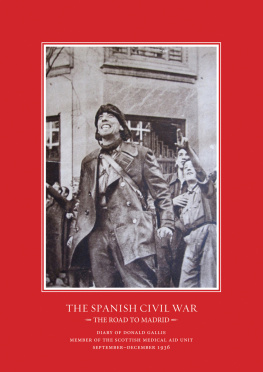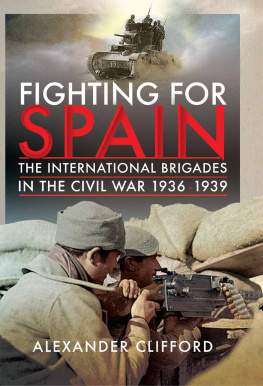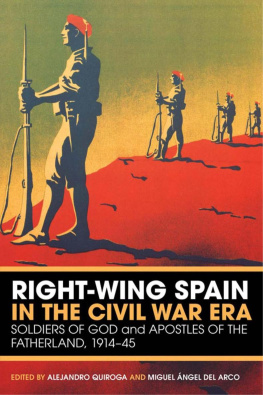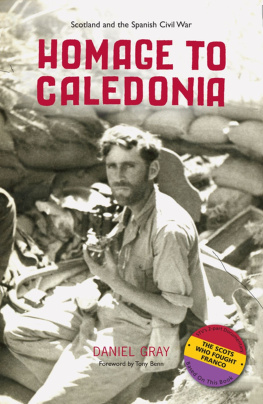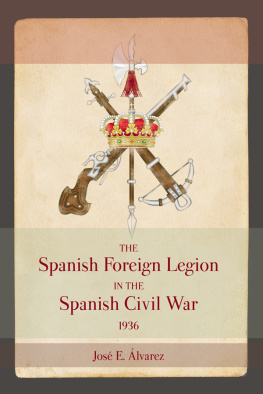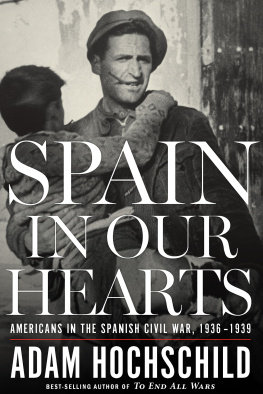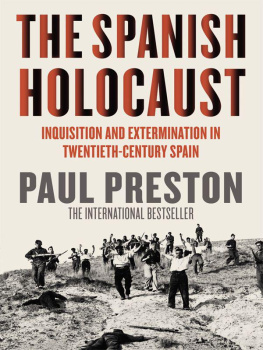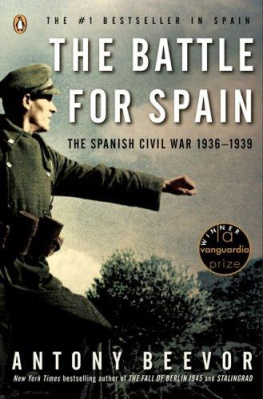
THE SPANISH CIVIL WAR
The Road to Madrid
THE DIARY OF DONALD GALLIE
MEMBER OF THE SCOTTISH MEDICAL AID UNIT
THE SPANISH CIVIL WAR SEPTEMBERDECEMBER 1936
Transcribed and edited by Donald Gallies daughter, Nina Stevens
Photograph below by Michael Gallie

Donald Gallie 19111999
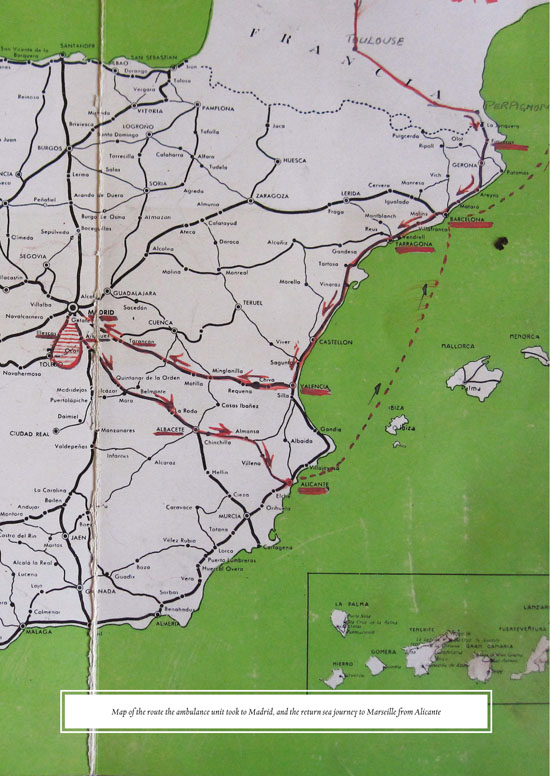
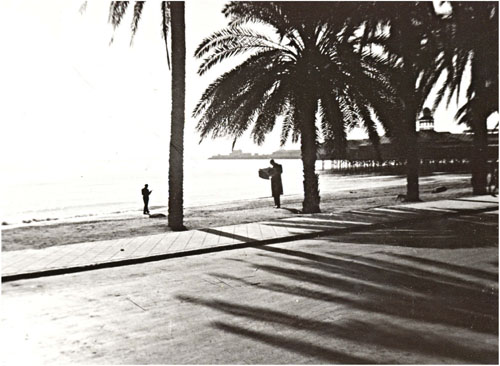
Sea-front Esplanade Alicante 1936
ACKNOWLEDGEMENTS : I would like to thank Linda Palfreeman for writing the Introduction, Richard Baxell and Jim Jump for their encouragement and support, and Denis Havard for coordinating the book design.
Family and friends mentioned in Donald Gallies Diary
Donalds parents, Charles and Margaret Gallie
Roy, Donalds brother and his girlfriend, Edna Kenley
Betty, Donalds sister
Karin, Donalds girlfriend in Sweden
Cousins in Belfast, Emma, Alex and Aileen
Uncle George, his mothers brother
Family friends Mrs. Oswald and Mr. and Mrs. Robert Holley
Front cover: The Russian planes arrive in Madrid on November 6th 1936
Page : La Pasionara statue for the freedom of Spain sculpted by Artur Dooley stands on
Custom House Quay, Glasgow. (photograph by Nina Stevens)
All photos (except eight) were taken by Donald Gallie
Copyright Nina Stevens, 2019.
Published in the Sussex Academic e-Library, 2019.
SUSSEX ACADEMIC PRESS
PO Box 139, Eastbourne BN24 9BP, UK
Ebook editions distributed worldwide by
Independent Publishers Group (IPG)
814 N. Franklin Street
Chicago, IL 60610, USA
ISBN 9781789760293 (Paperback)
ISBN 9781782846642 (Epub)
ISBN 9781782846642 (Kindle)
ISBN 9781782846642 (Pdf)
All rights reserved. Except for the quotation of short passages for the purposes of criticism and review, no part of this publication may be reproduced, stored in a retrieval system, or transmitted, in any form or by any means, electronic, mechanical, photocopying, recording or otherwise, without the prior permission of the publisher.
British Library Cataloguing in Publication Data
A CIP catalogue record for this book is available from the British Library.
This e-book text has been prepared for electronic viewing. Some features, including tables and figures, might not display as in the print version, due to electronic conversion limitations and/or copyright strictures.
Contents
Introduction
When a failed right wing military coup provoked civil war in Spain, in July 1936, the Spanish government made a worldwide plea for help. The British government (like the governments of other countries such as France and the United States) declared a policy of non-intervention. Nevertheless, ordinary citizens of these countries responded en masse. In Britain, Aid Spanish Committees sprang up in every major town and city, nationwide. Film shows, ftes, rallies and fairs, book clubs and cake sales were among the great variety of events held in towns and villages throughout the country, in order to raise funds to send aid to Spain. They were used with the dual aim of both raising money for Spain and of highlighting the Republican cause. The National joint committee for Spanish Relief (NJCSR) was set up to coordinate these many and varied fundraising enterprises.
In Scotland there was a tremendous support for the Spanish Republic, even in areas wracked by poverty and unemployment. By mid-1937, Glasgow alone had 15 NJCSR groups.
Nowhere was empathy more keenly felt for the working people of Spain than among the people of Glasgow, which became the hub of the Scottish Aid for Spain movement. At the citys May Day celebrations in 1937, 15,000 people turned out to demonstrate their solidarity with the Spanish Republic. Gray (2009) describes the fervor aroused by the conflict:
Political meetings on the subject of Spain became commonplace in Glasgow. As a happy side-effect they acted as fundraisers, with buckets passed around for donations. In terms of attendance, the meetings were an overwhelming success; it seemed Glaswegians had become as fanatical about the Spanish Republic as they were about Celtic and Rangers.
An Aid Spain shop was established at 11 Union Street, Glasgow, as a collection centre for food, milk and medical supplies as well as for monetary donations. Businesses contributed food and other goods for Spain and factory workers gave their free time to prepare and pack consignments whilst garages repaired and reconditioned vehicles for use as ambulances and other evacuation transport. Glasgow was also home to an enterprise which was to make a significant contribution to the Spanish Republicthe Scottish Ambulance Unit.
The Scottish Ambulance Unit was the brainchild of a wealthy Glaswegian philanthropist Sir Daniel Macaulay Stevenson (18511944). Stevenson became involved in civic affairs in the 1890s, being elected to Glasgows City Council in 1892. He later served as City Treasurer and then as Lord Provost, from 1911 to 1914, when he received a baronetcy. Stevenson was responsible for a number of socially progressive measures in the city, including making cultural facilities more accessible to working class Glaswegians.
After his retirement from politics, Stevenson continued to lend his support to worthy causesespecially that of furthering international understanding among young peoplea project which he pursued as Chancellor of the University of Glasgow.
In early September 1936, Sir Daniel Macaulay Stevenson created a committee of well-known Scottish academics and aristocracy to provide backing for his plan to send out a medical unit to the Spanish Republic. As well as relying on public donations, funding for the SAU came in no small part from Sir Daniel himself, his wealthy friends and from the Trades Union Congress (TUC).
Eventually the Scottish Ambulance Unit was ready to depart. It comprised six ambulances and a supply truck carrying stores and medical equipment, together with a team of twenty volunteers (19 men and one woman). There was one doctor, Louis Levin as well as drivers, mechanics, first-aiders and other helpers. John Boyd and Fred McMahon were from Belfast and the rest were from Glasgow and the west of Scotland: Robert Budge, George Burleigh, William Cox, George Crawford, William Freebairn (son of ex-Provost Freebairn), Harry Girvan, Duncan Johnstone, Angus McClean, Alex McLennan, Duncan Newbigging, Walter Perfect, Ernst Porter, Herbert Richmond, Thomas Watters and Donald Gallie. The only woman in the team was the Units commandant, Fernanda Jacobsen.
Not long after its arrival in Spain, the Unit was pitched into active duty. It set up headquarters in Aranjuez, some fifty kilometers south of Madrid from where it served on the Toledo front to the south-west of the capital. During the early days of the conflict the Units help proved invaluable to the Sanidad Militar , still in a state of relative disorganization and stretched to its limits due to heavy casualties. During fierce fighting, and in great personal danger to themselves, the Scottish volunteers rescued fallen Republican troops at Olias del Rey, Illescas and Cabaas dela Segra, administering first aid and ferrying the wounded to hospitals in Madrid. From here onwards, the Authorities would call upon the services of the SAU whenever there was an action resulting in (or likely to result in) significant numbers of casualties.
Next page
